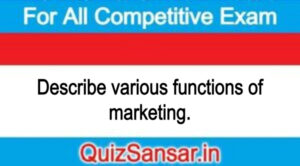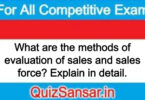
Describe various functions of marketing.
Describe various functions of marketing.
Or
Discuss ‘Scope of Marketing’.
Most widely accepted marketing functions can be classified into following three categories:
1. Functions of Exchange:
(a) Buying and Assembling: Buying is the first step in marketing functions. Buying means the purchase of raw materials for using in manufacturing process or purchase of finished goods for the purpose of resale.
Assembling involves bringing together a wide variety of goods, bought from different places under a common roof for resale. This function is primarily performed by the middlemen.
(b) Selling: It means finding the customers and transferring the goods to them for value. It involves transferring the title of goods to the buyers. It also involves product planning, creation of demand, contacting the buyers, gotiation the terms of sale etc.
2. Functions of Physical Supply:
(a) Transportation: It is concerned with carrying the goods from the places of production to the places of consumption. It widens the market and increases the mobility of labour. It creates place utility and thus enhances the value of goods.
(b) Storage: This process is concerned with retaining and preserving goods between the time of their production and the time of their sale. It creates time utility. It brings about equalisation of demand and supply by bridging the gap between the time of production and the time of consumption. It stablises prices of products and brings about normal market conditions.
3. Facilitating Functions:
(a) Financing: Finance is the life blood of modern business. According to F. J. Pyle., “Money or credit is the lubricant that facilitates the operation of marketing machine as modern marketing requires vast resources.” It is the service of providing credit and money necessary for the producer or seller to enable him make goods available to the consumers. Financing should also be available in adequate amounts to face trade cycles, recession and other such critical situations. Various sources of money are commercial banks, co-operative societies, Govt. agencies like financial corporation.
(b) Risk Taking (Insurance): A marketing enterprise, sometimes, has to bear innumerable risks in the process of marketing. These risks may be due to unforeseen circumstances like fire, accidents, damage to goods due to rain or social hazards as theft, burglary, risks arising during transportation, risks due to fluctuation of prices, bad debts etc. Most of the risks can be avoided by taking precautionary measures only. Insurance, however, is a device for granting protection against some of the business risks. Marketing makes use of insurance to safeguard such risks.
(c) Market Research: Market research is a systematic investigation. of the facts relevant to various aspects in marketing with a view to facilitate the decision-making process. It is the source through which the seller is able to know the tastes and preferences, likes and dislikes of the consumers, the intensity of a market competition, external forces and their impact etc. With the information available marketing decides price policies, reduces or makes. adjustments in costs where necessary and takes strategic decisions to combat competition.
(d) Sales Promotion: By this function marketing makes efforts to stimulate customers to purchase more and more of a particular commodity. It influences the attitudes, behaviour and purchase decision of consumers. This special function of sales promotion is effectively used by marketing to create, capture and maintain demand.
(e) Product Planning and Development: It is concerned with anticipating customers needs, developing new products and improving existing products so as to meet the expectations of the customers.
(D) Price Determination: It is the process of fixing the price of a product or service. Marketing performs this important function using factors as demand for the product, nature of product, extent of competition, cost of product, conditions of market, Government regulations etc.






